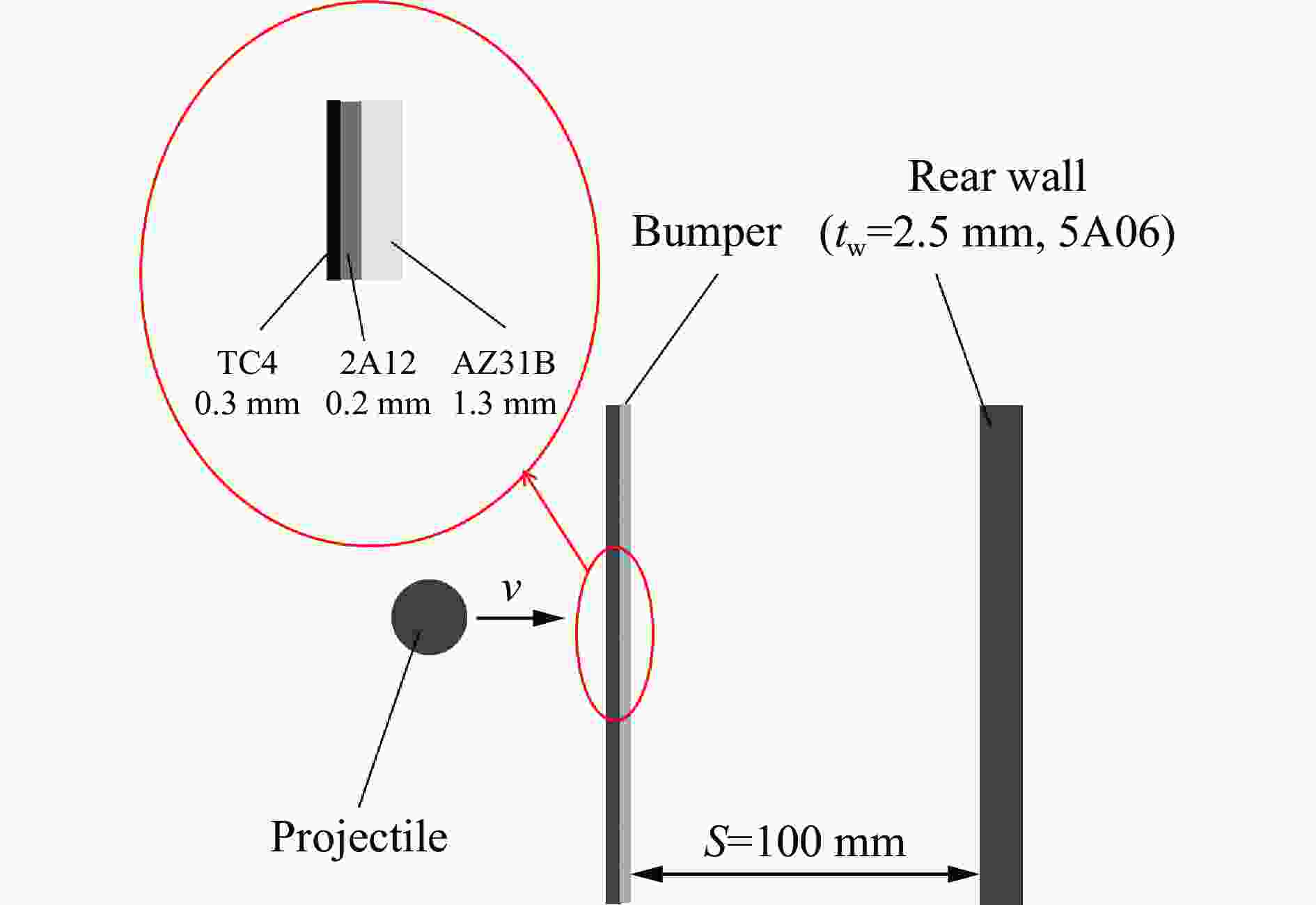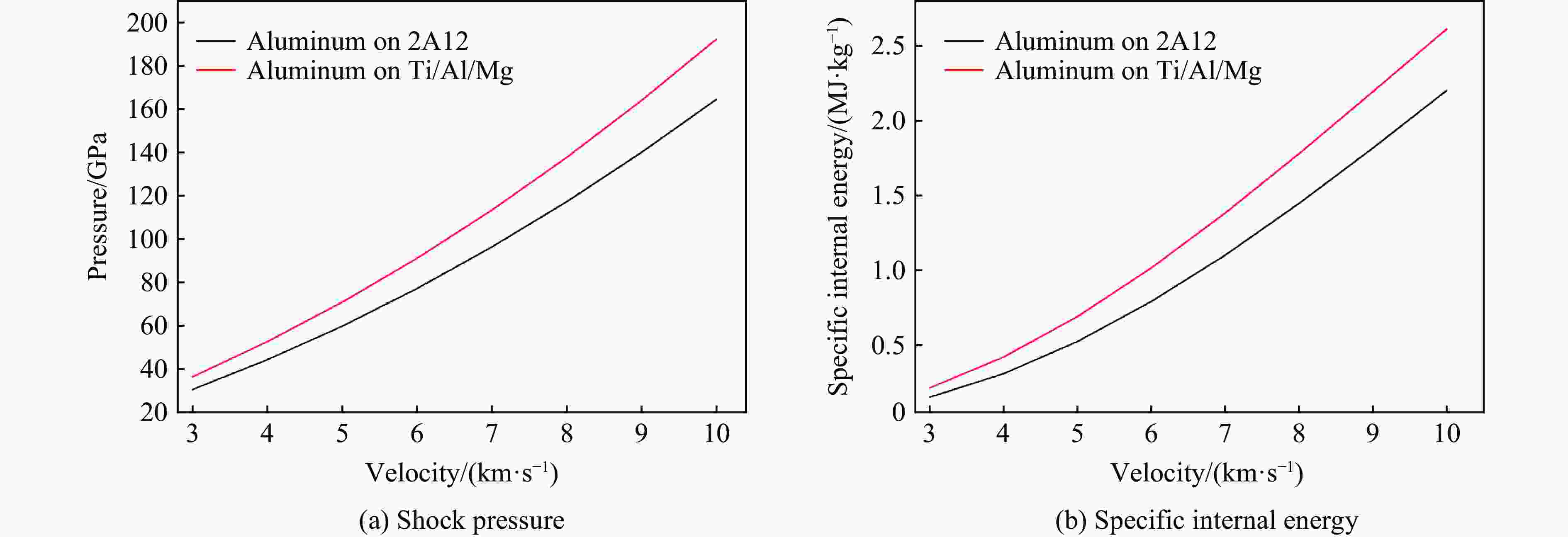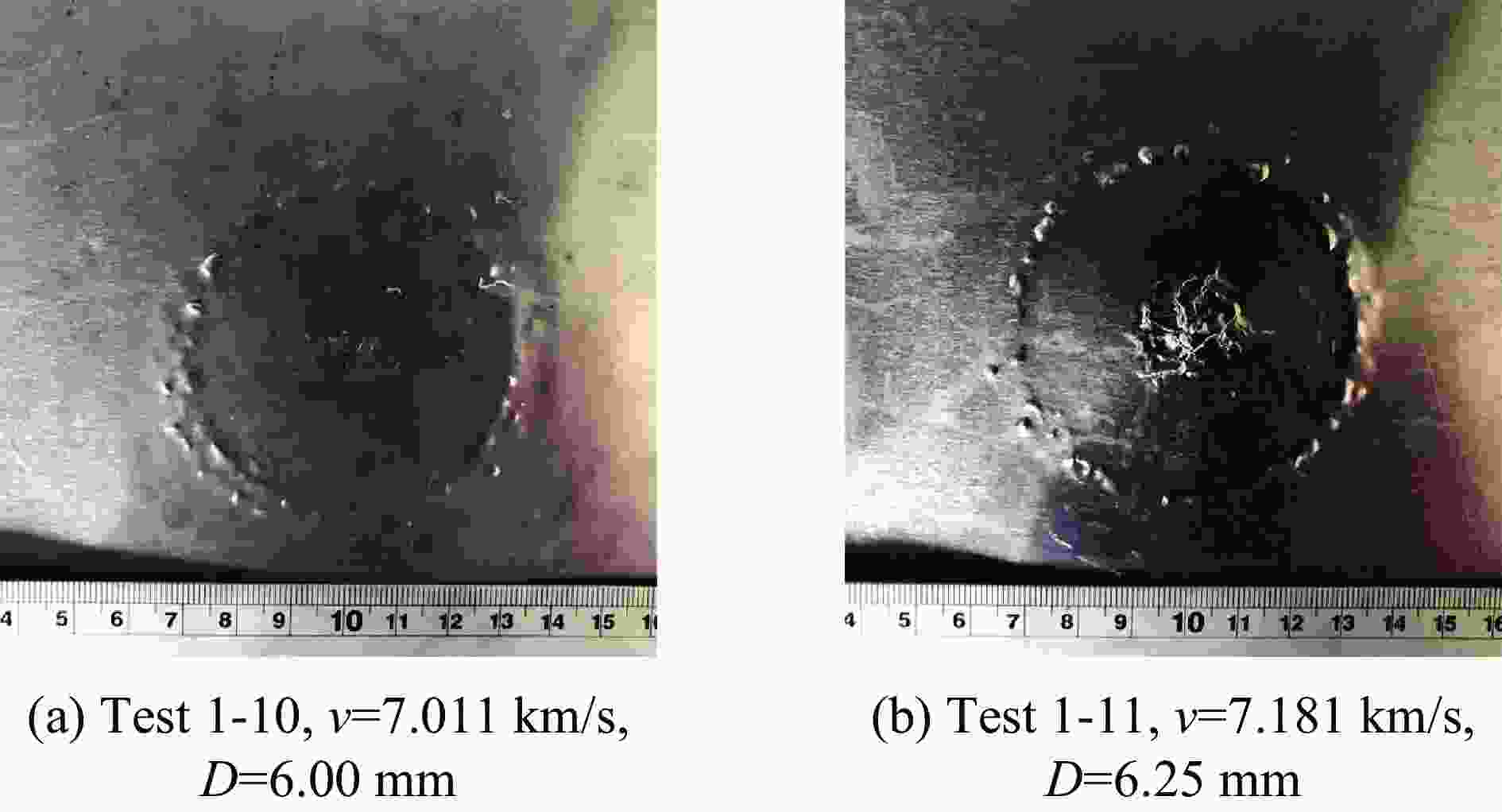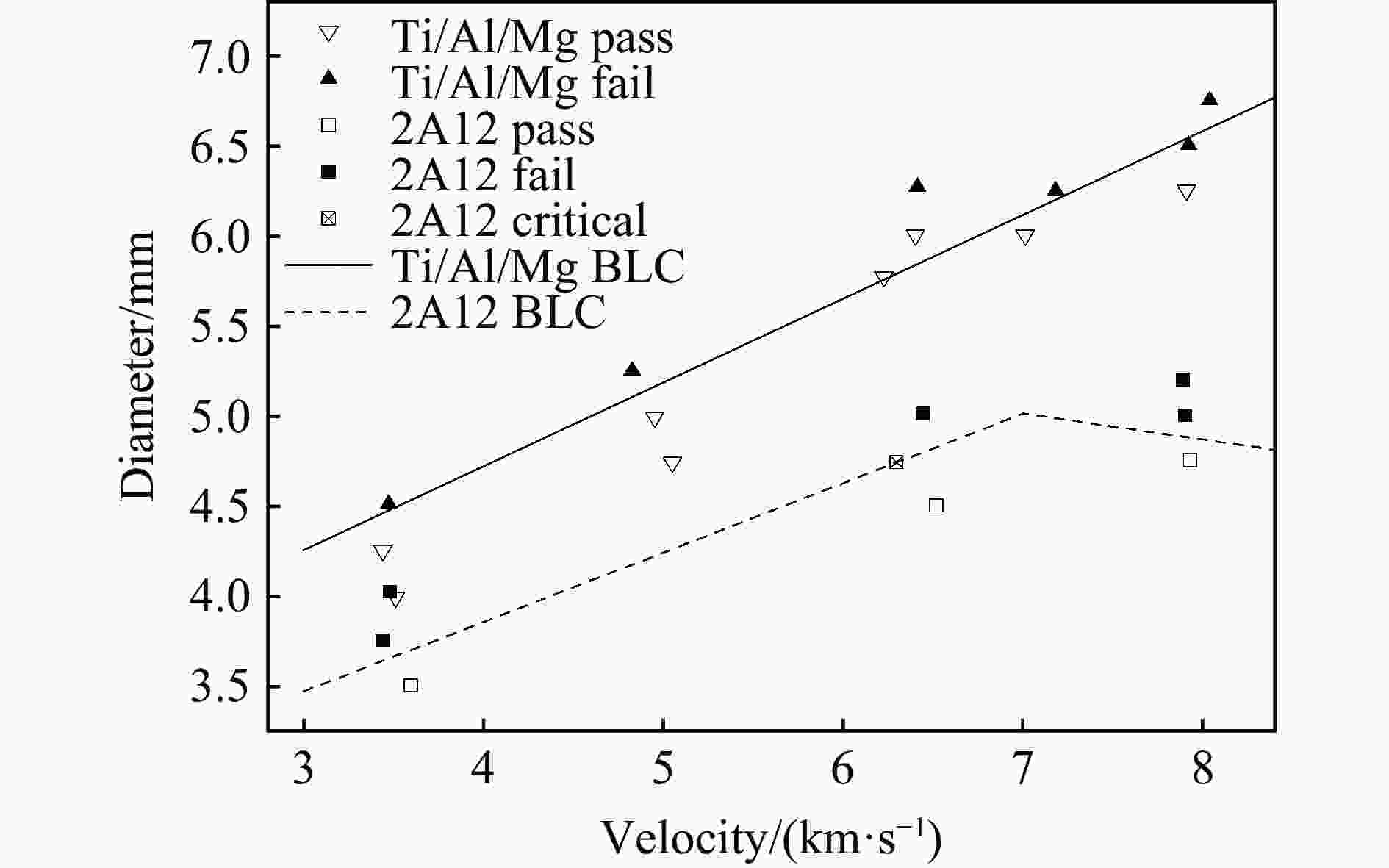Ballistic limit of an impedance-graded-material enhanced Whipple shield
-
摘要: 为研究一种改进型的波阻抗梯度材料防护结构Ti/Al/Mg结构的撞击极限,采 用 二 级 轻 气 炮 以3.0~8.0 km/s的速度对Ti/Al/Mg结构、Al/Mg结构和2A12结构开展了超高速撞击实验,建立了Ti/Al/Mg结构的撞击极限曲线。结果表明:高阻抗的钛合金表层能产生更高的冲击压力和温升,使弹丸充分破碎;在面密度相同的条件下,与Al/Mg结构和2A12结构相比,Ti/Al/Mg结构具有更强的防护性能。通过理论计算得到Ti/Al/Mg结构撞击极限曲线的区间转变速度小于7.0 km/s,但其实验撞击极限曲线上并未出现明显的区间转变,在实验速度范围内,撞击极限随着撞击速度的提升而增大,这与典型Whipple结构撞击极限曲线存在差异。
-
关键词:
- 超高速撞击 /
- Whipple 结构 /
- 阻抗梯度材料 /
- 撞击极限 /
- 空间碎片
Abstract: Impedance-graded-material enhanced Whipple shields have excellent protective performance. The purpose of this paper is to study the ballistic limit of Ti/Al/Mg shields, which is an improved impedance-graded-material enhanced Whipple shield. Hypervelocity impact experiments on Ti/Al/Mg, Al/Mg and 2A12 shields were performed using a two-stage light-gas gun at impact velocities of 3.0–8.0 km/s. The hypervelocity impact characteristics, the ballistic limit curve and shielding performance of the Ti/Al/Mg shields were studied. The reason of its excellent performance is explained by comparative analysis. As the impact velocity increases, the failure mode of the rear wall showed a detached spall or tearing damage instead of tiny perforations similar to an aluminum shield. The results show that a high-acoustic-impedance titanium alloy layer can generate higher shock pressures and induce a greater temperature increase, which is more effective for fragmenting an impacting projectile. The shock pressure and specific internal energy in the projectile increased by 23.0% and 30.7% compared to the aluminum on aluminum impact event at 8.0 km/s, respectively. The shielding capability of a Ti/Al/Mg shield is significantly greater than that of 2A12 and Al/Mg shields when the bumper has the same areal density. The critical projectile diameter of Ti/Al/Mg shields is 6.58 mm at ~8.0 km/s, which is an improvement of approximately 34.8 % compared to the 4.88 mm of aluminum shields. Finally, to explore the transition velocities of the ballistic limit curve of the Ti/Al/Mg shields, a theoretical analysis was conducted, which suggests that for an aluminum projectile impacting a Ti/Al/Mg bumper, this value might be <7.0 km/s. However, a transition point is not apparent in the experimental ballistic limit curve, and the critical projectile diameter increases with increasing velocity in the range of 3.0–8.0 km/s. It is different from the typical Whipple shield. Further hypervelocity impact tests and additional research needs to be conducted to study in detail the ballistic limit of the Ti/Al/Mg shields.-
Key words:
- hypervelocity impact /
- Whipple shield /
- impedance-graded material /
- ballistic limit /
- space debris
-
表 1 超高速撞击实验参数与结果
Table 1. Hypervelocity impact test conditions and results
实验 结构类型 撞击速度/(km·s−1) 弹丸直径/mm 失效状态 实验 结构类型 撞击速度/(km·s−1) 弹丸直径/mm 失效状态 1-1 Ti/Al/Mg 3.512 3.99 未失效 2-1 2A12 3.596 3.50 未失效 1-2 Ti/Al/Mg 3.440 4.25 未失效 2-2 2A12 3.440 3.75 失效 1-3 Ti/Al/Mg 3.473 4.51 失效 2-3 2A12 3.480 4.02 失效 1-4 Ti/Al/Mg 5.051 4.74 未失效 2-4 2A12 6.518 4.50 未失效 1-5 Ti/Al/Mg 4.951 4.99 未失效 2-5 2A12 6.296 4.74 临界 1-6 Ti/Al/Mg 4.827 5.25 失效 2-6 2A12 6.442 5.01 失效 1-7 Ti/Al/Mg 6.227 5.77 未失效 2-7 2A12 7.170 5.00 失效 1-8 Ti/Al/Mg 6.400 6.00 未失效 2-8 2A12 7.930 4.75 未失效 1-9 Ti/Al/Mg 6.412 6.27 失效 2-9 2A12 7.900 5.00 失效 1-10 Ti/Al/Mg 7.011 6.00 未失效 3-1 2A12 3.540 4.25 失效 1-11 Ti/Al/Mg 7.181 6.25 失效 3-2 Al/Mg 3.476 4.24 临界 1-12 Ti/Al/Mg 7.907 6.25 未失效 3-3 2A12 6.079 5.73 失效 1-13 Ti/Al/Mg 7.920 6.50 失效 3-4 Al/Mg 6.332 5.74 失效 1-14 Ti/Al/Mg 8.037 6.75 失效 -
[1] WHIPPLE F L. Meteorites and space travel [J]. Astronomical Journal, 1947, 52(5): 131. DOI: 10.1086/106009. [2] SCHMIDT R M, HOUSEN K R, BJORKMAN M D, et al. Advanced all-metal orbital debris shield performance at 7 to 17 km/s [J]. International Journal of Impact Engineering, 1995, 17(4): 719–730. DOI: 10.1016/0734-743X(95)99894-W. [3] 郭运佳, 文雪忠, 黄洁, 等. 不同填充层材料的空间碎片防护结构性能试验研究 [J]. 航天器环境工程, 2020, 37(6): 589–595. DOI: 10.12126/see.2020.06.009.GUO Y J, WEN X Z, HUANG J, et al. Experimental study of shielding performance of protecting structures stuffed with different materials [J]. Spacecraft Environment Engineering, 2020, 37(6): 589–595. DOI: 10.12126/see.2020.06.009. [4] 黄鑫, 凌中, 刘宗德, 等. 梯度复合Whipple防护结构的超高速撞击实验 [J]. 爆炸与冲击, 2013, 33(S1): 92–98.HUANG X, LING Z, LIU Z D, et al. Hypervelocity impact experiments on new gradient Whipple shield structure [J]. Explosion and Shock Waves, 2013, 33(S1): 92–98. [5] HOFMANN D C, HAMILL L, CHRISTIANSEN E, et al. Hypervelocity impact testing of a metallic glass-stuffed Whipple shield [J]. Advanced Engineering Materials, 2015, 17(9): 1313–1322. DOI: 10.1002/adem.201400518. [6] PUTZAR R, ZHENG S G, AN J, et al. A stuffed Whipple shield for the Chinese space station [J]. International Journal of Impact Engineering, 2019, 132: 103304. DOI: 10.1016/j.ijimpeng.2019.05.018. [7] CHRISTIANSEN E L. Meteoroid/debris shielding [R]. Houston, USA: NASA, 2003. [8] CHRISTIANSEN E L, NAGY K, LEAR D M, et al. Space station MMOD shielding [J]. Acta Astronautica, 2009, 65(7/8): 921–929. DOI: 10.1016/j.actaastro.2008.01.046. [9] ZHANG P L, GONG Z Z, TIAN D B, et al. Comparison of shielding performance of Al/Mg impedance-graded-material-enhanced and aluminum Whipple shields [J]. International Journal of Impact Engineering, 2019, 126: 101–108. DOI: 10.1016/j.ijimpeng.2018.12.007. [10] 张品亮, 宋光明, 龚自正, 等. Al/Mg波阻抗梯度材料加强型Whipple结构超高速撞击特性研究 [J]. 爆炸与冲击, 2019, 39(12): 125101. DOI: 10.11883/bzycj-2018-0461.ZHANG P L, SONG G M, GONG Z Z, et al. Shielding performances of a Whipple shield enhanced by Al/Mg impedance-graded materials [J]. Explosion and Shock Waves, 2019, 39(12): 125101. DOI: 10.11883/bzycj-2018-0461. [11] HUANG X, LING Z, LIU Z D, et al. Amorphous alloy reinforced Whipple shield structure [J]. International Journal of Impact Engineering, 2012, 42: 1–10. DOI: 10.1016/j.ijimpeng.2011.11.001. [12] ZHANG P L, XU K B, LI M, et al. Study of the shielding performance of a Whipple shield enhanced by Ti-Al-nylon impedance-graded materials [J]. International Journal of Impact Engineering, 2019, 124: 23–30. DOI: 10.1016/j.ijimpeng.2018.08.005. [13] 宋光明, 李明, 武强, 等. 超高速撞击下波阻抗梯度防护结构碎片云特性研究 [J]. 爆炸与冲击, 2021, 41(2): 021405. DOI: 10.11883/bzycj-2020-0299.SONG G M, LI M, WU Q, et al. Debris cloud characteristics of graded-impedance shields under hypervelocity impact [J]. Explosion and Shock Waves, 2021, 41(2): 021405. DOI: 10.11883/bzycj-2020-0299. [14] LONG L P, PENG Y B, ZHOU W, et al. Study on hypervelocity impact characteristics of Ti/Al/Mg density-graded materials [J]. Metals, 2020, 10(5): 697. DOI: 10.3390/met10050697. [15] LONG L P, LIU W S, MA Y Z, et al. Microstructure and diffusion behaviors of the diffusion bonded Mg/Al joint [J]. High Temperature Materials and Processes, 2017, 36(9): 897–903. DOI: 10.1515/htmp-2016-0023. [16] PIEKUTOWSKI A J, POORMON K L. Impact of thin aluminum sheets with aluminum spheres up to 9 km/s [J]. International Journal of Impact Engineering, 2008, 35(12): 1716–1722. DOI: 10.1016/j.ijimpeng.2008.07.023. [17] GRADY D E, KIPP M E. Experimental measurement of dynamic failure and fragmentation properties of metals [J]. International Journal of Solids and Structures, 1995, 32(17): 2779–2791. DOI: 10.1016/0020-7683(94)00297-A. [18] MEYERS M A. 材料的动力学行为 [M]. 张庆明, 刘彦, 黄风雷, 等, 译. 北京: 国防工业出版社, 2006: 83. [19] 谭华. 实验冲击波物理导引 [M]. 北京: 国防工业出版社, 2007. [20] 经福谦. 实验物态方程导引 [M]. 2版. 北京: 科学出版社, 1999. [21] MARSH S P. LASL shock hugoniot data [M]. California, USA: University of California, 1980. [22] ANDERSON C E Jr, TRUCANO T G, MULLIN S A. Debris cloud dynamics [J]. International Journal of Impact Engineering, 1990, 9(1): 89–113. DOI: 10.1016/0734-743X(90)90024-P. [23] MCQUEEN R G, MARSH S P. Equation of state for nineteen metallic elements from shock-wave measurements to two megabars [J]. Journal of Applied Physics, 1960, 31(7): 1253–1269. DOI: 10.1063/1.1735815. [24] 徐锡申, 张万箱. 实用物态方程理论导引 [M]. 北京: 科学出版社, 1986. [25] CHRISTIANSEN E L, KERR J H. Ballistic limit equations for spacecraft shielding [J]. International Journal of Impact Engineering, 2001, 26(1−10): 93–104. DOI: 10.1016/S0734-743X(01)00070-7. [26] SCHONBERG W P. Using modified ballistic limit equations in spacecraft risk assessments [J]. Acta Astronautica, 2016, 126: 199–204. DOI: 10.1016/j.actaastro.2016.03.038. -







 下载:
下载:









